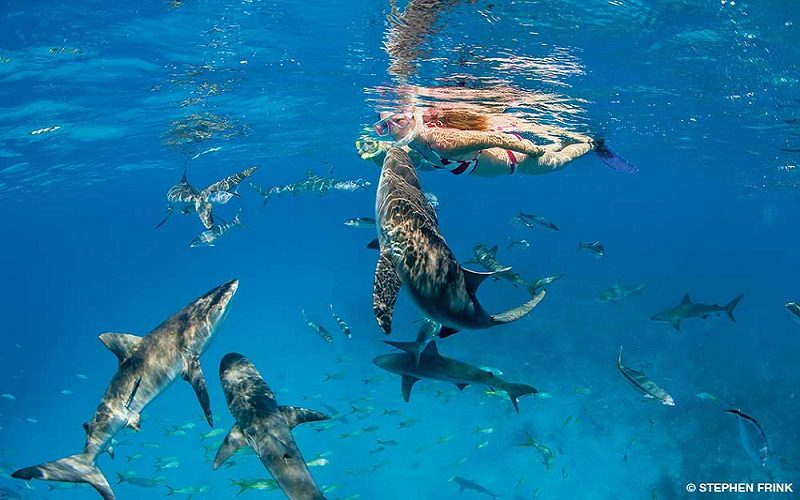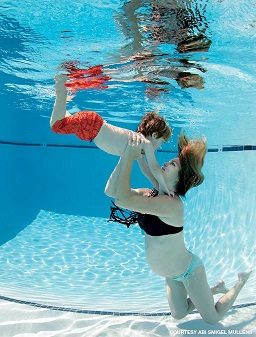When it comes to fitness for diving, the recommendations for male and female divers are largely the same: good exercise tolerance, a healthy weight and awareness of possible concerns related to medical conditions and medications. Regardless of sex, all divers should use appropriate thermal protection, remain hydrated, understand the diving environment and dive conservatively.
Men and women, however, are physically and physiologically different. With women representing about a third of the recreational diving population — in 2013 the Professional Association of Diving Instructors (PADI) reported its population of certified divers as 66 percent male and 34 percent female, and males represent 64 percent of insured DAN members1 — it is important to consider specific health concerns that female divers face.
Thermoregulation

For both men and women, body temperature is centrally controlled in the hypothalamus and is affected by factors such as body fat content, fat distribution and body surface-area-to-mass ratio. Hormonal differences may affect thermoregulation, but body composition and size typically drive responses to cold exposure. Total heat loss may be greater in women because they generally have higher surface-area-to-volume ratios and lower muscle mass compared with men (greater muscle mass is associated with greater metabolic heat production). Some research suggests that women’s body temperature falls more rapidly during immersion in cold water while at rest. The bottom line is that every diver should wear a suit that fits well and keeps him or her warm — exposure protection helps compensate for any heat loss due to hormonal or anthropometric differences.
Menstruation
No evidence suggests that women who dive while menstruating are harassed or bitten by sharks more often. However, anxiety, dizziness, feeling cold and the potential for panic may be exaggerated during menstruation or premenstrual syndrome (PMS). Temporary iron deficiency during menstruation may reduce exercise capacity, so women should be prepared to modify their diving behavior if necessary. Menstruation can trigger migraines, which are more common in women than men. Delay diving if migraine symptoms occur.
Research suggests there may be a slight increase in risk for decompression illness during the follicular stage of the menstrual cycle (the roughly two-week span preceding ovulation). Everyone should dive within established limits, but women might consider reducing their diving exposure during the follicular stage by incorporating additional conservatism into their dive plan. Completely refraining from diving while menstruating is not necessary, but women should be aware of how PMS and menstruation affects them and whether emotional stress, irritability, cramping, headaches or associated symptoms might compromise dive safety.
Oral Contraceptives
Use of oral contraceptives (as well as a sedentary lifestyle and long-distance travel) may contribute to possible clot formation such as deep vein thrombosis. Research indicates that oral contraceptive pill (OCP) use can increase the risk of a thromboembolic event such as a pulmonary embolism, heart attack or stroke. A 1985 report showed that women who use OCPs and smoke more than 25 cigarettes per day have a 23-fold increased risk for a thromboembolic event compared with those who do not smoke.5 While a thromboembolic event may be at least somewhat manageable on dry land, it would be unmanageable in the water. Quitting smoking, exercising regularly and moving frequently during long trips can help minimize the risk of an emergency due to clot formation.
Pregnancy
Not only should pregnant women refrain from diving, women who think they may be pregnant or are trying to become pregnant should likewise avoid it. For ethical reasons there has never been experimental research investigating the effects of diving on a fetus. The retrospective anecdotal data regarding pregnancy and diving shows there may be a risk to the fetus should a mother continue diving during pregnancy. A survey of 208 mothers who dived during pregnancy showed higher rates of low birth weight, birth defects, neonatal respiratory difficulties and other problems.2

Decompression studies conducted on sheep demonstrated that a fetus may develop bubbles before the mother displays clinical symptoms of decompression sickness.3,4 (Sheep studies are relevant because the placentas of sheep and humans are similar.) The fetus runs the potential risk of death because the fetal cardiovascular system has no effective filter. Therefore, any bubbles formed are likely to go directly to the brain and coronary arteries. All sheep studies showed very high rates of fetal loss. Although it is limited, the available data seem to suggest strongly that women should refrain from diving while pregnant or trying to conceive.
As with scuba diving, the data on freediving and pregnancy are limited, with most data coming from Japanese ama divers and Korean haenyo divers. Freediving for pearls and abalone is a way of life for these divers, most of whom are women. Many ama divers continue to freedive well into pregnancy without many adverse effects, although profiles are modified based on gestation. Conservative freediving during pregnancy may be considered a safe activity for enjoyment or relaxation (provided good maternal and fetal health), but it should not be considered an ideal form of exercise. DAN® recommends that pregnant women consult their doctor before beginning any new exercise activity.
The recommendations regarding a return to diving after childbirth vary based on the type of delivery. After a normal vaginal delivery without complications, a woman can resume diving in about 21 days. This allows time for the cervix to close, which limits the risk of infection. An uncomplicated cesarean section generally means eight to 12 weeks of not diving to allow the mother to regain stamina and cardiovascular fitness. If a woman is put on bed rest due to complications, waiting more than 12 weeks is prudent because of deconditioning and loss of aerobic capacity and muscle mass. Following a miscarriage, a woman can return to diving when the physician releases her for full, unrestricted activity.
Breastfeeding
Diving is considered safe for mothers who are breastfeeding. Nitrogen does not accumulate in breast milk, so there is no risk of the baby absorbing dissolved nitrogen through breastfeeding. But diving can be dehydrating and may thus interfere with milk production, so appropriate hydration is important.
Cosmetic and Reconstructive Procedures
Fitness to dive following plastic surgery depends on the procedure. For instance, Botox injections, which relax facial muscles to reduce the appearance of wrinkles, typically require very little down time. Diving can be considered as soon as the treating physician feels there is no risk of infection. Dermal fillers warrant more consideration since they are designed to add volume to reduce the appearance of wrinkles. The concern is not the ambient pressure in the diving environment but rather displacement of the filler caused by pressure from the diver’s mask. The treating physician can offer advice on the time required for the displacement of fillers to no longer be a risk.
Diving after major plastic surgery such as abdominoplasty (a “tummy tuck”) or breast implants is deemed safe once the treating physician has released the patient for full and unrestricted activity — six to eight weeks is typical for these types of procedures. Caution should be taken when diving with breast implants. Avoid constricting buoyancy compensator straps to prevent undue stress on the implants. Keep in mind that saline implants are neutrally buoyant, but silicone is negatively buoyant and may alter a diver’s trim in the water.
Aging & Menopause
The average age of the diving population is increasing. According to DAN membership data from 2000 to 2006, the average age of male members was 44, the average age of female members was 42, and the average age of both sexes increased significantly over the four-year period.1 With aging comes special considerations for female divers. The symptoms of menopause can be both physical and emotional, including anxiety, decreased energy, hot flashes, sleep disruption and mood changes. Nonetheless, menopause is not a contraindication to diving, assuming symptoms do not compromise dive safety, nor is it the greatest risk for aging female divers. Medical concerns associated with aging — such as hypertension, heart disease and diabetes — require greater attention, as they are more likely to affect diving.

Postmenopausal women are at increased risk of certain medical conditions such as cardiovascular disease, stroke and osteoporosis. Hormone replacement therapy, which can be used to relieve some symptoms of menopause, may provide cardiovascular protection in younger menopausal women (age 50-54) but may increase the risk of plaque rupture in older menopausal women.
Cardiovascular Health
According to the American Heart Association, cardiovascular disease kills more women than all forms of cancer. DAN fatality reports show that cardiac incidents are among the top three disabling injuries in diving fatalities, regardless of sex.1,6 Signs and symptoms of a cardiac event can differ between women and men. Women are less likely to report chest pain during a heart attack, which may result in incorrect diagnoses and treatment delays. Cardiovascular disease can be misdiagnosed as dive-related illnesses, especially in women because of the increased incidence of ambiguous symptoms such as fatigue, malaise and/or flulike symptoms. In any emergency situation, timely first aid is critical, but quick and appropriate intervention in a diving context can be challenging.
Osteoporosis
Preventative health for women as they age includes awareness of the increased risk of osteoporosis, which can be determined by a bone density test. The National Osteoporosis Foundation recommends that women receive a bone density test if they meet any of the following criteria: they have broken a bone after age 50, they are of menopausal age with risk factors, they are under 65 years of age and postmenopausal with risk factors, or are 65 years of age or older. Compromised bone health is not a contraindication for diving, but women who have been diagnosed with osteoporosis or severe bone loss should consider avoiding wearing heavy dive gear such as tanks and weights while out of the water. Divers with osteoporosis should adapt their diving to reduce the risk of fractures and falls by putting on tanks in the water, avoiding carrying tanks on land and avoiding hazardous shore entries such as rocky beaches.
Relative Risk
A comparison of fatality rates by age and sex of DAN members determined that men were 2.8 times more likely than women to die while diving.1 Some people might conclude this means men are more likely to engage in risky behaviors than women, but that would be speculation.
Summary
Male and female divers have more similarities than differences. To dive safely, both must be physically fit, competent and properly trained for the environment they dive in. But understanding health considerations of particular relevance to women, such as pregnancy, thermal regulation and the differences in symptoms of cardiovascular problems, is useful to all women who dive — and those who dive with them.
References
- Denoble PJ, Pollock NW, Vaithiyanathan P, Caruso JL, Dovenbarger JA, Vann RD. Scuba injury death rate among insured DAN members. Diving and Hyperb Med. 2008; 38(4):182-188.
- Bolton ME. Scuba diving and fetal well-being: A survey of 208 women. Undersea Biomed Res. 1980; 7(3):183-189.
- Fife WP, Simmang C, Kitzman JV. Susceptibility of fetal sheep to acute decompression sickness. Undersea Biomed Res. 1978; 5(3):287-292.
- Powell MR, Smith MT. Fetal and maternal bubbles detected noninvasively in sheep and goats following hyperbaric decompression. Undersea Biomed Res. 1985; 12(1):59-67.
- Rosenberg L, Kaufman DW, Helmrich SP, et al. Myocardial infarction and cigarette smoking in women younger than 50 years of age. JAMA 1985; 253(20):2965-2969.
- Denoble PJ, Caruso JL, Dear GdL, Pieper CF, Vann RD. Common causes of open-circuit recreational diving fatalities. Undersea Hyperb Med. 2008; 35(6):393-406.
© Alert Diver — Q3 Summer 2015